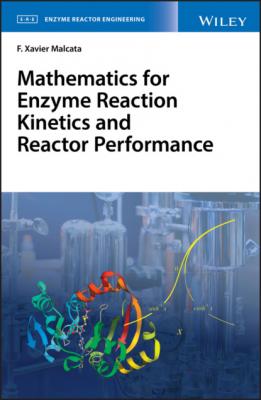Mathematics for Enzyme Reaction Kinetics and Reactor Performance. F. Xavier Malcata
Читать онлайн.| Название | Mathematics for Enzyme Reaction Kinetics and Reactor Performance |
|---|---|
| Автор произведения | F. Xavier Malcata |
| Жанр | Химия |
| Серия | |
| Издательство | Химия |
| Год выпуска | 0 |
| isbn | 9781119490333 |
(3.98)
in view of the commutative and associative properties of addition of scalars; Eq. (3.95) may again be invoked to retrieve Eq. (3.70) with the aid of Eqs. (3.1) and (3.2), since ux vx + uy vy + uz vz = u · v and ux wx + uy wy + uz wz = u · w – and a similar reasoning would likewise generate Eq. (3.74).
Equation (3.95) also leads to a number of other useful relationships; one of the most famous starts from vector w, defined as
according to Fig. 3.3d, after having obtained −v as symmetrical of vector v as in Fig. 3.3 b; and added to u as in Fig. 3.3c – while u and v remain consistent with Fig. 3.3a. According to Eq. (3.99), the scalar product of w by itself reads
(3.100)
whereas combination with Eq. (3.55) leads to
after taking square roots of both sides, Eq. (3.101) becomes
(3.102)
where Eq. (3.99) was again invoked – so the length of a difference of vectors equals the square root of its scalar product by itself. In view of Eq. (3.70), one may rewrite Eq. (3.101) as
(3.103)
and a second application of the said distributive property conveys
(3.104)
insertion of Eq. (3.55) supports transformation to
(3.105)
whereas application of Eq. (3.58) further justifies
– also at the expense of the associative property of scalars. On the other hand, the definition of scalar product as per Eq. (3.53) permits reformulation of Eq. (3.106) to
thus retrieving Eq. (2.443) – as long as a ≡ ‖ u ‖, b ≡ ‖ v ‖, γ ≡ ∠ u,v, and c ≡ ‖ w ‖. Equation (3.107) applies to the sides of the triangle in Fig. 3.3e, obtained, in turn, from that in Fig. 3.3d following counterclockwise rotation, so as to make u lie on the horizontal axis – followed by vertical and horizontal flipping (for graphical convenience). Remember that when u and v are normal to each other, the cosine of the angle between them is nil – so Eq. (3.107) would reduce to
(3.108)
under such circumstances; this is but Pythagoras’ theorem as per Eq. (2.431), with w playing the role of hypotenuse, and u and v playing the roles of sides of the right angle. This is illustrated in Fig. 3.3f in terms of sides u and v, with hypotenuse w generated in Fig. 3.3g as vector connecting the extreme points of u and v . The said theorem was proven previously based on Newton’s expansion of a difference, see Eqs. (2.432) and (2.433); it is possible to resort to a similar expansion of its conjugate, as illustrated in Fig. 3.3h. Two squares are accordingly considered therein – one with side a + b, and a smaller one with side c that is rotated as much as necessary to have its four corners simultaneously touch the sides of the original square; this originates four right triangles, all with hypotenuse c, and sides a and b. The area of the larger square is (a + b)2, which may in turn be subdivided into the area of the smaller square, c2, plus the areas of four identical triangles – each one accounting for ab/2, according to
(3.109)
expansion of the left‐hand side following Newton’s binomial, coupled with replacement of 4/2 by 2 in the right‐hand side, yields
(3.110)
